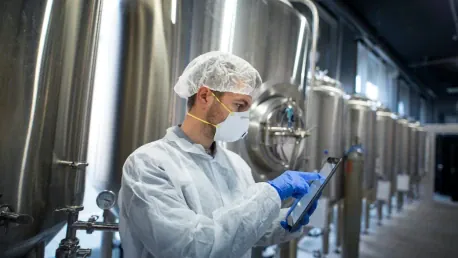The upstream bioprocessing market is experiencing unprecedented growth, with projections indicating a surge from USD 24.16 billion in 2023 to an astounding USD 105.30 billion by 2034. This remarkable expansion is driven by several key factors, including the rising demand for biopharmaceuticals, technological advancements, and strategic industry collaborations. This article delves into the primary drivers behind this growth, providing a comprehensive analysis of the market dynamics and future trends.
Market Overview and Growth Projections
Current Market Size and Future Projections
The global upstream bioprocessing market was valued at USD 24.16 billion in 2023. With a projected Compound Annual Growth Rate (CAGR) of 14.32%, the market is expected to reach USD 105.30 billion by 2034. This growth is fueled by the increasing demand for biopharmaceuticals and the rapid expansion of the biotechnology industry.
A significant driver of this market expansion is the escalating demand for biopharmaceuticals, which are essential for treating various complex diseases and conditions. Technological advancements in upstream processes, such as more efficient bioreactors and fermenters, are enabling larger-scale and more cost-effective production, thereby contributing to market growth. Additionally, the biopharmaceutical industry is seeing an increase in research and development (R&D) investments, focusing on innovative treatments and personalized medicine, which is expected to further boost the market.
Key Drivers of Market Expansion
Several factors contribute to the market’s growth, including technological advancements in upstream bioprocessing, increased R&D spending by biopharmaceutical firms, and a heightened focus on personalized medicine. Significant mergers and acquisitions, such as Getinge’s acquisition of Purity New England, Inc., also underscore the sector’s dynamic nature and growth potential.
Another crucial driver is the rise in strategic collaborations and partnerships within the industry. Such alliances allow for the sharing of expertise, resources, and technology, fostering innovation and accelerating the development of new products. For instance, the collaboration between Cytiva and Culture Biosciences highlights how combined efforts can lead to advanced upstream bioprocessing solutions, ultimately driving market growth. These collaborations not only enhance technological capabilities but also help in navigating regulatory landscapes, ensuring smoother and faster approval processes for new biopharmaceuticals.
Regional Market Insights
North America: Leading the Charge
North America is forecasted to command the highest revenue share in the upstream bioprocessing market. This dominance is attributed to the presence of key biopharmaceutical companies, a robust research infrastructure, and a supportive regulatory environment. The region’s substantial biopharmaceutical activities and favorable regulatory climate in the U.S. and Canada are major contributors to this growth.
The United States, in particular, represents a critical hub for biopharmaceutical innovation, boasting several leading companies in the field. The region’s strong focus on R&D and significant government support through initiatives like the Biologics Price Competition and Innovation Act have also helped in fostering a conducive environment for market growth. Furthermore, the availability of funding and grants from various federal agencies, such as the National Institutes of Health (NIH), plays a pivotal role in sustaining research efforts and propelling the upstream bioprocessing market forward.
Asia-Pacific: Fastest Growing Region
The Asia-Pacific region is set to exhibit the fastest CAGR during the forecast period. This growth is driven by increasing investments in biopharmaceutical manufacturing, expanding healthcare infrastructure, and rising demand for affordable biologics. Collaborations like the one between Cytiva and Culture Biosciences to introduce advanced upstream bioprocessing solutions highlight the region’s growing significance.
China, Japan, and India are leading the charge in the Asia-Pacific region, with significant investments in biotech infrastructure and capabilities. The region benefits from a large pool of skilled professionals, competitive manufacturing costs, and favorable government policies supporting the biotech industry. Additionally, ongoing efforts to enhance healthcare accessibility and affordability make Asia-Pacific a promising market for biopharmaceuticals. Emerging markets in Southeast Asia and countries like South Korea and Australia are also increasingly contributing to the region’s dynamic growth by adopting advanced bioprocessing technologies.
Product Segmentation and Market Trends
Bioreactors and Fermenters: Top-Grossing Segment
In 2023, bioreactors and fermenters emerged as the top-grossing segment. This is due to the burgeoning interest in biopharmaceuticals and the application of cutting-edge bioprocessing techniques. The segment’s growth is further propelled by the expanding biopharmaceutical sector and the increasing demand for monoclonal antibodies and recombinant proteins.
These bioreactors and fermenters offer significant advantages in terms of scalability, efficiency, and control over the production processes, making them indispensable tools for biopharmaceutical manufacturers. Innovations in bioreactor design, such as single-use technologies and advanced control systems, are further enhancing their utility. Companies like GE Healthcare and Thermo Fisher Scientific are at the forefront of these innovations, continually improving bioreactor performance to meet the complex needs of modern biopharmaceutical production.
Cell Culture Products: Fastest Growing Segment
The cell culture products segment is predicted to witness the fastest growth. This is driven by the expanding biopharmaceutical sector and the increasing demand for monoclonal antibodies and recombinant proteins. The establishment of Lifera in Saudi Arabia by PIF exemplifies the segment’s growth into indigenous biomanufacturing, targeting vaccines, insulins, plasma therapies, monoclonal antibodies, cell and gene therapies, and small molecules.
This segment’s rapid expansion is also fueled by ongoing advancements in cell culture media and techniques, which are crucial for optimizing cell growth and productivity. The increasing adoption of single-use technologies in cell culture systems is providing further impetus to the segment’s growth. These technologies not only offer flexibility and cost savings but also reduce the risk of contamination, making them highly attractive for biopharmaceutical manufacturers. Additionally, strategic partnerships and collaborations aimed at enhancing cell culture capabilities are contributing significantly to the segment’s upward trajectory.
Workflow Analysis
Cell Culture: Leading the Revenue Charts
The cell culture segment led the revenue charts in 2023, owing to the rising demand for monoclonal antibodies, vaccines, and cell-based therapies. This segment is anticipated to sustain its growth trajectory, underlining the importance of cell culture in the biopharmaceutical production chain. Developments like GE Healthcare’s launch of the AKTA kestron bioprocess chromatography system enhance flexibility and efficiency in protein purification.
The cell culture workflow remains a cornerstone of upstream bioprocessing, pivotal in producing biologically active substances that are integral to various treatments. With continued innovation in cell line development, culture media, and bioreactor design, this segment is poised for further advancements. Furthermore, the integration of automation and digital technologies into cell culture processes is enhancing operational efficiency and consistency, which in turn is driving market growth. The increasing application of cell culture in developing gene and cell therapies marks another significant trend, expanding the segment’s scope and relevance.
Single-Use Systems: Rapid Growth
While multi-use systems dominated the 2023 market due to their cost-effectiveness for large-scale bioproduction, single-use systems are anticipated to grow the fastest. These systems offer advantages such as flexibility, reduced cross-contamination risks, and cost efficiencies. Danaher Corporation’s partnership with WuXi AppTec to deliver both upstream and downstream bioprocessing solutions typifies the evolving landscape favoring single-use technologies.
The rapid adoption of single-use systems is transforming upstream bioprocessing, providing solutions that are not only cost-effective but also highly adaptable to varying production scales and requirements. These systems facilitate faster turnaround times between production batches, minimizing downtime and increasing productivity. Moreover, single-use technologies are gaining traction due to their simplified cleaning and validation processes, which help in maintaining stringent regulatory compliance. Innovations in materials and design are further enhancing the performance and reliability of single-use systems, making them a preferred choice for an increasing number of biopharmaceutical companies.
Mode of Manufacturing
In-House Manufacturing: Top Spot
In-house manufacturing retained the top spot in terms of mode, primarily due to biopharmaceutical companies’ preference for greater control, customization, and proprietary processes. This approach allows companies to maintain stringent quality standards and optimize production processes.
The trend toward in-house manufacturing is driven by the necessity for high precision and consistency in biopharmaceutical production. Companies benefit from direct oversight of the manufacturing process, ensuring that quality control measures meet the rigorous standards required for biopharmaceutical products. Additionally, the ability to customize processes in-house allows for greater innovation and flexibility in developing new therapies. This mode also facilitates the protection of proprietary technologies and processes, which are critical competitive advantages in the biopharmaceutical industry.
Outsourcing: Rapid Expansion
Conversely, the outsourcing segment is set to expand rapidly as companies increasingly outsource bioprocessing roles for cost-effectiveness and operational flexibility. Innovations like Merck KGaA’s introduction of Ultimus, a single-use process container film, underscore the ongoing efforts to bolster both in-house and outsourced bioprocessing solutions.
Outsourcing bioprocessing services is becoming an attractive option for many biopharmaceutical companies looking to reduce operational costs and leverage external expertise. Contract manufacturing organizations (CMOs) offer specialized services that can enhance production efficiency and speed up time-to-market for new products. Additionally, outsourcing allows companies to scale production up or down based on demand, without the need to invest in costly infrastructure. The partnership between Danaher Corporation and WuXi AppTec exemplifies the strategic move towards integrating advanced bioprocessing solutions through outsourcing, enabling companies to focus on their core competencies while optimizing production capabilities.
End-User Analysis
Biopharmaceutical Companies: Leading Revenue Generation
Biopharmaceutical companies led revenue generation in 2023, fueled by the high demand for biologics and expansion initiatives. These companies are at the forefront of biopharmaceutical production, driving market growth through continuous innovation and strategic investments.
These firms invest significantly in R&D to develop novel therapeutics and optimize production processes, thereby maintaining their competitive edge. Their extensive pipelines of biologic drugs, including monoclonal antibodies, vaccines, and gene therapies, are crucial contributors to the upstream bioprocessing market. Additionally, biopharmaceutical companies are increasingly forming strategic alliances with academic institutions and other industry players to enhance their research capabilities and expand their product portfolios. Such collaborations facilitate the sharing of knowledge and expertise, fostering a synergistic environment conducive to growth and innovation.
Academic and Research Institutes: Swift Growth
Academic and research institutes play a crucial role in the upstream bioprocessing market. These entities are increasingly focusing on the development and optimization of bioprocessing techniques, contributing significantly to the market’s growth. Their involvement in pioneering research and development projects drives innovation within the industry, facilitating the discovery of new biopharmaceuticals and improving existing processes. Moreover, collaborations between academic institutions and biopharmaceutical companies help bridge the gap between fundamental research and practical applications, ensuring the efficient translation of scientific discoveries into market-ready products.









